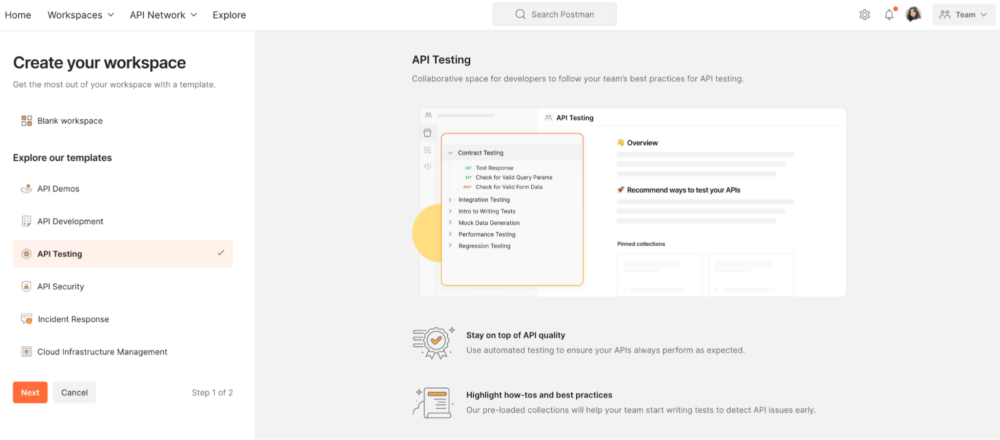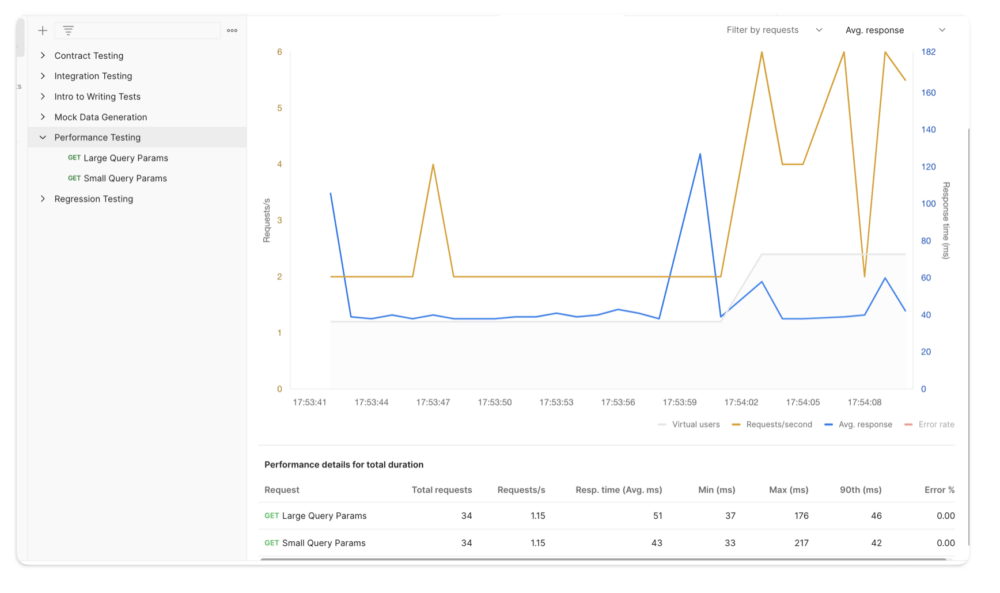Postman’s guide to 5 essential API testing techniques
Postman has revolutionized the way developers test APIs, offering a comprehensive set of tools and features that streamline the API testing process. In this blog post, we will explore the five essential testing techniques that can be performed with Postman: end-to-end testing, regression testing, integration testing, contract testing, and performance testing. Each technique plays a crucial role in ensuring the quality and reliability of APIs, and we’ll be using example collections in Postman’s API testing workspace template to streamline the process.
Let’s dive in and uncover the power of testing with Postman!

1. End-to-end testing
End-to-end testing plays a crucial role in validating complete workflows within an application. While unit testing focuses on verifying individual endpoints and their responses, end-to-end testing goes a step further by examining key user journeys that involve multiple endpoints and APIs. It ensures that the entire system functions correctly and helps identify potential issues within complex workflows before they impact users.
Postman allows you to perform end-to-end testing by chaining together unit tests in a collection, such as those in the Intro to Writing Tests collection. The collection that you use for end-to-end testing should include requests to each component in the given workflow. You can then use the Postman Collection Runner to execute the entire collection—or select specific requests within it. Once the collection run is complete, Postman will provide the results, indicating which tests passed and which tests failed.
If you’re interested in learning more about chaining requests, check out this post about building Postman request workflows.
2. Regression testing
Regression tests are designed to verify that your API continues to operate as expected after you implement updates or modifications. They help maintain the overall reliability of your API by identifying potential bugs or issues that are introduced during development cycles.
Our Regression Testing example collection demonstrates how some key API elements are commonly covered in regression testing:
- Status code verification: This test ensures that the API consistently returns the expected status codes for different types of requests. By validating status codes, you can ensure that proper error handling and response reliability are maintained.
- JSON schema verification: Verifying the adherence of the JSON response to a specified JSON schema is vital in maintaining API contracts. This type of regression test ensures that the structure and format of the response align with the defined schema.
- Response time verification: Optimizing API performance is essential for providing a smooth user experience. Regression tests that verify the API’s response time help ensure that the API’s performance remains within acceptable limits.
- Response body verification: The structure and content of the response body are critical for accurate data transmission. Regression tests that validate the response body help safeguard the integrity of the data and prevent potential downstream issues.
- Header verification: Response headers play a crucial role in secure and well-structured communication between your application and its consumers. Regression tests confirm the presence and correctness of these headers, which helps maintain a reliable interaction.
To execute regression tests efficiently, you can use automation tools like the Postman CLI. Additionally, scheduled runs enable you to monitor these tests over time, providing valuable insights into the reliability of your API. By incorporating regression testing into your development process, you can confidently introduce changes to your workflow or API while mitigating the risk of unexpected issues.
3. Integration testing
As your application grows and evolves, it becomes crucial to ensure that its different components function harmoniously and interact seamlessly. Integration testing plays a pivotal role in verifying the compatibility of various modules, such as routes, validations, application logic, and data layers within your system. This type of testing is especially instrumental in assessing how well your application interacts with external systems, including databases and third-party services.
Integration testing allows you to evaluate the behavior and functionality of your application as a whole, ensuring that it functions smoothly and delivers the expected results when integrated with other systems or components. In the Integration Testing example collection, there are three endpoints for registering and receiving a token, accessing your unique generated name, and unregistering a token:
- POST
/register - POST
/unregister - GET
/my-name
By setting up requests in the order of the operation, we can test the flow of data to and from the endpoints and ensure they work together as expected.
4. Contract testing
An API contract is a human- and machine-readable representation of an API’s intended functionality. It establishes a single source of truth for what each request and response should look like—and forms the basis of service-level agreements (SLAs) between producers and consumers. API contract testing helps ensure that new releases don’t violate the contract by checking the content and format of requests and responses.
Contract testing helps you validate that your implementation of a contract matches the required specifications. The Contract Testing example collection demonstrates how to set up tests to spot deviations from the contract’s specifications for endpoints, parameters, and request/response schemas.
5. Performance testing
Performance testing is a testing technique that is used to determine how well a system performs under different workloads. It is essential for ensuring that a system can handle a large number of requests and respond quickly.
Postman’s API performance testing feature now allows you to:
- Simulate load by having multiple parallel virtual users hit your endpoints.
- Visualize key API performance metrics—such as response times, throughput (requests hit per second), and error rates—under the simulated load in real time.
The Performance Testing example collection contains pre-built requests that simulate large and small query parameters, which can help you assess how well your API handles different loads. You can use this collection to learn how to test your APIs by configuring:
- Virtual users (VUs): The maximum number of parallel users you want to simulate.
- The test duration: The amount of time (in minutes) for which you want to run the test.
- The load profile: The intensity of the load during the test’s duration. We currently support a “fixed” load profile, which applies a fixed number of virtual users throughout the test’s duration, and a “ramp up” load profile, which slowly increases the number of virtual users until it reaches the specified load.

Start testing your APIs with Postman
Postman’s comprehensive testing capabilities empower developers and quality assurance teams to ensure the reliability, functionality, and performance of their APIs. From end-to-end testing to performance testing, each technique plays a crucial role in validating an API’s overall quality. Keep exploring the example collections referenced in this post, which you can adapt as you continue on your testing journey.

What do you think about this topic? Tell us in a comment below.